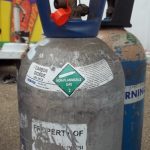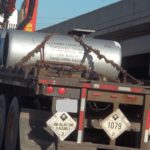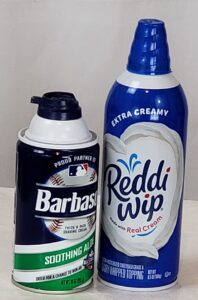Introduction:
Aerosols are a common product found in almost every residential and commercial setting. They are also – usually – a hazardous material (HazMat) subject to the Hazardous Materials Regulations (HMR) of the Pipeline and Hazardous Materials Safety Administration within the U.S. Department of Transportation (USDOT/PHMSA) when transported or offered for transport within the U.S. However, an exception from most of the HMR is available to aerosols – and other compressed gasses – at 49 CFR 173.306. The purpose of this article is to identify and explain the limited quantity exception for aerosols in metal containers at 49 CFR 173.306(i).
Before we begin…
Aerosol v. aerosol container:
- Aerosol is defined at 49 CFR 171.8:
Aerosol means an article consisting of any non-refillable receptacle containing a gas compressed, liquefied or dissolved under pressure, the sole purpose of which is to expel a nonpoisonous (other than a Division 6.1 Packing Group III material) liquid, paste, or powder and fitted with a self-closing release device allowing the contents to be ejected by the gas.
- Also, the classification of an aerosol as a Class 2 Compressed Gas is found at §173.115(l)
- Aerosol container is not defined, but its specifications are described at §178, Subpart B.
Therefore, Aerosol is the HazMat regulated by USDOT/PHMSA and aerosol container is the packaging authorized for its transportation.
|
Contact me with any questions you may have about the transportation of hazardous materials by air, highway, vessel, or rail International and Domestic |
Scope and Applicability:
This article is limited solely to the following:
- The transportation in commerce of HazMat to, from, or through the U.S. International transportation of aerosols will not be considered in this article.
- The mode of transportation is by highway, rail, or vessel. The transportation of aerosols by aircraft will not be within the scope of this article.
- The use of a metal container for the inner packaging of an aerosol. Plastic aerosol containers may be used in some situations (see §173.306(a)(5)) but will not be within the scope of this article.
What is an aerosol?
As noted earlier, aerosol is defined at §171.8. Key points of its definition include:
- It is an article.
- It consists of a non-refillable receptacle. This distinguishes it from most compressed gas cylinders which are refillable.
- The non-refillable receptacle contains one of the following gas types:
- Compressed
- Liquefied
- Dissolved under pressure.
- The sole purpose of the aerosol is to expel one of the following:
- Liquid
- Paste
- Powder
- The liquid, paste, or powder must be non-poisonous. However, a Division 6.1 Poison Packing Group III is allowed.
- The aerosol is fitted with a self-closing release device which allows the contents to be ejected by the gas.
Q: What about a pressurized metal canister containing a liquefied gas whose sole purpose is to expel that gas as a liquid? In other words, there is no liquid, paste, or powder in the container, just the liquefied gas. Is that an aerosol eligible for the limited quantity exception of §173.306(i)?
A: No. A liquefied compressed gas packaged without a liquid, paste, or powder in the container does not meet the definition of an aerosol and, therefore, is not eligible for the exception. (LOI 17-0098 & LOI 09-0290)
Q: A mixture of propane and silicone oil in a container under pressure is used to both operate (primarily) and lubricate (secondarily) toy guns. Does this meet the definition of an aerosol and therefore be eligible for the limited quantity exception?
A: No. The sole purpose of an aerosol must be to expel a liquid, paste, or powder. In this situation, the sole purpose of this product is not to disperse the lubricant but to both operate and lubricate the toy gun. Therefore it does not meet the definition of an aerosol at §171.8 and is not eligible for the limited quantity exception. (LOI 07-0095)
|
Interested in a Webinar that covers this topic, and more! |
Aerosols are classified as a Class 2 gas at §173.115(l). These regulations are summarized below.
- An aerosol may be assigned to Division 2.1 Flammable Gas or Division 2.2 Non-Flammable Gas.
- An aerosol that is neither Division 2.1 or 2.2 must be classed in accordance with the appropriate tests of the UN Manual of Tests and Criteria. Therefore, it is possible – but unlikely – an aerosol would be classed as something other than a Class 2.
- A Division 2.3 Poison Gas may not be transported in an aerosol container.
- An aerosol may have a subsidiary hazard class of Division 6.1 Poison (PG III only) or Class 8 Corrosive (PG II or III), as appropriate. However, Packing Group I or II Poisons or Packing Group I Corrosives are forbidden from transport in an aerosol container.
- Flammable components of an aerosol must be one of the following:
- Class 3 Flammable Liquid
- Division 4.1 Flammable Solid
- Division 2.1 Flammable Gas
- The chemical heat of combustion for the flammable components of an aerosol container must be determined in accordance with the UN Manual of Tests and Criteria.
Classification of Aerosols:
The Hazardous Materials Table contains the following classifications for aerosols:
- UN1950, Aerosols, corrosive, Packing Group II or III, (each not exceeding 1 L capacity), 2.2 (8)
- UN1950, Aerosols, flammable, (each not exceeding 1 L capacity), 2.1
- UN1950, Aerosols, flammable, n.o.s. (engine starting fluid) (each not exceeding 1 L capacity), 2.1
- UN1950, Aerosols, non-flammable, (each not exceeding 1 L capacity), 2.2
- UN1950, Aerosols, poison, Packing Group III (each not exceeding 1 L capacity), 2.2 (6.1)
And a few others….
- Pepper spray, see Aerosols, etc. or Self-defense spray, non-pressurized
- Self-defense spray, aerosol, see Aerosols, etc.
- Tear gas devices, with not more than 2 percent tear gas substances, by mass, see Aerosols, etc
Column 8 of the Hazardous Materials Table refers to the section in Part 173 of Title 49 where the authorized packing for the HazMat can be found. In this situation, every one of the above classifications – except engine starting fluid – has only one section indicated for authorized packaging: “306”. This means that for almost all aerosol classifications, the sole packing instructions to refer to can be found only at 49 CFR 173.306.
Read: Determining Authorized Packaging for the Transportation of a Hazardous Material
Therefore, our next step will be to refer to §173.306 to determine the authorized packaging and any packing instructions for UN1950, Aerosols, etc.
|
Like this article? Subscribe to my Monthly Newsletter No marketing emails! |
Packing Instructions of 49 CFR 173.306 Limited quantities of compressed gases:
A few things before we proceed through §173.306:
- The packing instructions for a limited quantity of UN1950, Aerosols, etc. are found in paragraph (i) of §173.306. However, that is not the place to start. A shipper must go through §173.306 in order, beginning with paragraph (a) and proceeding to (i) when directed to it as an option. That is how this article is arranged.
- As noted in Scope and Applicability, this article will only address the transportation of aerosols by motor vehicle, rail, or vessel; transport by aircraft will not be considered.
- §173.306 contains packing instructions for many articles containing compressed gases besides aerosols in metal containers, including:
- Gas samples at (a)(4).
- Division 2.2 non-flammable gases in plastic aerosols (a)(5).
- Foodstuffs, soap, biologicals, electronic tubes, and audible fire alarm systems at (b).
- (c) – (d) are reserved.
- Refrigerating machines at (e).
- Accumulators at (f).
- Water pump system tank (g).
- Lighter refills at (h).
- Aerosols and receptacles small, containing gas with a capacity of less than 50 mL at (j).
- Aerosols for recycling or disposal at (k).
- Additional exceptions at (l).
- Reverse logistics at (m).
§173.306(a):
- The following are not required for a limited quantity of a compressed gas:
- HazMat labels – unless required by a condition of the exception.
- DOT specification packaging.
- Placards on vehicles transporting this HazMat.
- The rail car operator requirements of Part 174 – except for the requirement for a shipping paper at §174.24.
- The motor carrier requirements of Part 177 – except for the requirement for a shipping paper at §177.817.
- Each package must not exceed 30 kg (66 lb) gross weight.
- Subject to §173.306(a)(1), containers of not more than 4 fluid ounces (7.22 cubic inches) capacity – except cigarette lighters – are eligible for this exception. “Additional exceptions for certain compressed gases in limited quantities and the ORM-D hazard class are provided in paragraph (i) of this section.” That means, if an aerosol container meets the criteria and conditions of this paragraph, it is also eligible for the limited quantity exception at §173.306(i).
- §173.306(a)(2) is applicable solely to refillable metal containers. Therefore it is not applicable to aerosols and is not addressed in this article.
- §173.306(a)(3) identifies the authorized metal containers for an aerosol – provided certain conditions are met. Authorized containers include the following designs:
- Non-specification.
- DOT 2P per §178.33.
- DOT 2Q per §178.33a.
- DOT 2Q1 per §178.33(d).
- Those “certain conditions”:
- The capacity of the container must not exceed 1 L (61.0 cubic inches).
- The general pressure conditions of §173.306(a)(3)(ii) must be met according to the type of metal aerosol container.
- The liquid content of the material and gas must not completely fill the container at 45.4 °C (130 °F).
- The containers must be packed in a strong outer packaging. The strong outer packaging is not required to be a DOT specification packaging.
- Each aerosol container, after it is filled, must be subjected to a test performed in a hot water bath per §173.306(a)(3)(v) – unless one of the alternative tests are used.
- Alternatives to the hot water bath include:
- Alternative water bath test at §173.306(a)(3)(v)(A).
- Automated pressure test at §173.306(a)(3)(v)(B).
- Weight test at §173.306(a)(3)(v)(C).
- Leakage test at §173.306(a)(3)(v)(D).
- Alternatives to the hot water bath include:
- Each outer packaging must be marked: “INSIDE CONTAINERS COMPLY WITH PRESCRIBED REGULATIONS”
And…
- “Additional exceptions for aerosol containers conforming to this paragraph (a)(3) are provided in paragraph (i) of this section.” That means, if an aerosol container meets the criteria and conditions of paragraph §173.306(a)(3), a shipper may refer to paragraph §173.306(i) for additional exceptions as a limited quantity.
- §173.306(a)(4) applies to gas samples and is not addressed in this article.
- §173.306(a)(5) applies to Division 2.2 non-flammable gases with no subsidiary hazard in a plastic aerosol container. A description of these regulations will have to wait for a later article.
|
Daniels Training Services, Inc. 815.821.1550 |
§173.306(b):
This paragraph describes exceptions for limited quantities of the following compressed gas HazMat:
- Foodstuffs
- Soap
- Biologicals
- Electronic tubes
- Audible fire alarm systems
This paragraph also directs a shipper to §173.306(i) where additional exceptions as a limited quantity are available with this text: “Additional exceptions for certain compressed gases in limited quantities and the ORM-D hazard class are provided in paragraph (i) of this section.”
Broadly speaking, this exception is very similar to the one offered for metal aerosol containers in §173.306(a) with some less stringent requirements – e.g., a plastic aerosol container is authorized. However, a full explanation of this exception will have to wait until a later article.
§173.306(c) – (h):
This article will not address these paragraphs applicable to several different types of compressed gases. Instead, I will jump to the most critical paragraph of this section for limited quantities or aerosols in metal containers…
§173.306(i):
- To be eligible for the limited quantity exception as described in this paragraph, the HazMat must conform to the provisions of one of the earlier paragraphs of this part (addressed earlier in this article):
- §173.306(a)(1): containers of not more than 4 fluid oz.
- §173.306(a)(3): a metal aerosol container.
- §173.306(a)(5): a division 2.2 gas with no subsidiary risk in a plastic aerosol container.
- §173.306(b): foodstuffs, soap, biologicals, electronic tubes, and audible fire alarm systems.
- §173.306(h) (unless transportation is by aircraft): lighter refills.
Q: So, in order to be eligible for the limited quantity exception at §173.306(i) a shipper of an aerosol in a metal container must first comply with the regulations of §173.306(a)(3)?
A: Yes. Conformity with §173.306(a)(3) – or (a)(1), (a)(5), or (b) as applicable – is required before the limited quantity exception of §173.306(i) is available.
Also…
- Each package must display the limited quantity mark per §172.315(a) or (b).
- Outside packagings are not required to be marked: “INSIDE CONTAINERS COMPLY WITH PRESCRIBED REGULATIONS”.
- Each package must conform with the general packaging requirements of 173, subpart B.
- Each package must not exceed 30 kg (66 lb) gross weight.
- A metal aerosol container that conforms with §173.306(i) is excepted from the following:
- HazMat labels.
- Specification packaging when packed in a combination packaging.
- Shipping papers. Unless the HazMat is one of the following:
- Hazardous substance
- Hazardous waste
- Marine pollutant
- Transported by aircraft or vessel.
- Placards
|
Interested in site specific training at your site that covers this topic, and more! Ask me about my Onsite Training |
Q: An aerosol container eligible for the limited quantity exception at §173.306(i) is not required to be marked: INSIDE CONTAINERS COMPLY WITH PRESCRIBED REGULATIONS”, but is required to display the limited quantity mark?
A: Yes. While the display of the mark: “INSIDE CONTAINERS COMPLY WITH PRESCRIBED REGULATIONS” remains an option, it no longer is a requirement under this exception. The limited quantity mark however, is required.
Conclusion:
The limited quantity exception for aerosols in metal containers as described in §173.306 is not as clear as it might be. However, by navigating through the section correctly, a shipper should be able to find that most metal containers of aerosols are eligible for the limited quantity exception at §173.306(i).





